“A world power embarrassing itself.”
That’s how one prominent German magazine described the US’s decentralized, state-based approach to COVID-19 last year. The fact that the US government didn’t prescribe a national lockdown strategy, but left the decision on restrictions to the states, seemed bewildering and chaotic to many in Europe.
One year later, the tide had turned and Germans under stay-at-home orders watched in disbelief as the US started to return to normal life with a vaccination speed four times that of Germany.
What happened?
A Top-Down Approach
Similar to the US, German law left the responsibility for imposing stay-at-home orders and other drastic restrictions in the hands of the states. Unlike in America, however, the restrictions were almost identical throughout the country. An informal, politically powerful gathering of the minister presidents of all German states together with Chancellor Merkel handed down all policies on lockdowns nationwide.
Think of it as akin to all governors and the president meeting and deciding a uniform COVID-19 policy for all of the country. It’s federalism in name only. The international media lauded Merkel’s response, with The Washington Post praising Germany as “one of the envies of the Western world” for its handling of COVID-19.
In the US, however, the restrictions in response to the coronavirus varied across the states. Some red states never closed down, and many like Georgia and Florida reopened early. Many blue states on the other hand, like California and New York, locked down longer and harsher.
And that’s federalism at work: State governments assessed the situation differently, some saw less risk in reopening to their citizens than others, some may have placed freedom and self-responsibility ahead of other concerns, or the simple fact that states are just vastly different, e.g. some more rural, others more urban.
A federal top-down one-size-fits-all approach would have neglected all of that. More importantly with state policy, unhappy citizens can always ultimately choose to vote with their feet and leave the state: For a substantial number, it was indeed the final straw to move out of certain blue-governed states like California.
The Harshest Lockdown Ever
While Germany eventually reopened in the summer, it closed down again just weeks before Christmas, cutting short the usual Christmas shopping. At the same time, the US was already administering the first vaccine shots. The new phase of restrictions in Germany was meant to be only a temporary time span of four weeks but ended up lasting for almost half a year. Amid the harshest lockdown ever in Germany, with restrictions like curfews, surpassing that of even the early days of the corona outbreak, the feds pushed state governments to agree to take it to the next level: Over Easter, for five days everything including supermarkets would close. Only on one of the five days would citizens be able to buy food for half a day. The announcement backfired and under public backlash, the decision was reversed within a day.
But days later, when some state governments began toying with the idea of “model openings,” a trial reopening of certain regions with low infection numbers, Merkel threatened a federal takeover of the corona-policy setting. More than one year into the pandemic the German parliament approved the power grab from the states and new, federally mandated stay-at-home orders ensured no state could deviate from the national strategy.
All the while, the American vaccination campaign was full speed ahead and several US states, including Texas and Florida, had returned to normal life.
A Sudden Admiration for the ‘Chaotic’ US
By now, Germany’s view of the US had dramatically shifted. Gone was the earlier view of a chaotic American Corona-Wild West. Instead, many Germans began to envy the pictures of American drive-through vaccination sites and Americans returning to normalcy, unthinkable in Germany, with slow, overly bureaucratic vaccination centers and restrictions harsher than one year before.
So what do we learn from this?
Just because decisions are made by a central government body, it doesn’t mean they’re the right decisions. The long phase of lockdowns in Germany may now be coming to an end, but it doesn’t look like it’s fully catching up to America’s progress on reopening and vaccination any time soon. And one can be pretty confident that many Texans or Floridians are probably not too keen on switching places with a German.
Decisions on drastic interventions in the daily life of everyday citizens are made best at the most local scale possible: ideally at the individual level, or at least at the local or state level, and not by federal officials far away contriving a one-size-fits-all plan.
Sebastian Thormann
Sebastian Thormann is a Young Voices Contributor and a student at the University of Passau, Germany. He has also written for the Washington Examiner, The National Interest, CapX and Townhall.com.
This article was originally published on FEE.org. Read the original article.


 It’s also worth noting that these numbers actually understate the charity gap between Americans and folks from other nations. Economic output in the United States is about 30 percent higher than it is in the rest of the developed world, so charitable giving by Americans actually represents a much bigger slice of a much bigger pie.
It’s also worth noting that these numbers actually understate the charity gap between Americans and folks from other nations. Economic output in the United States is about 30 percent higher than it is in the rest of the developed world, so charitable giving by Americans actually represents a much bigger slice of a much bigger pie. But even if you have the
But even if you have the